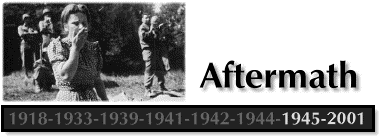
| | |

|
|
Beginning in the summer of 1945, a series of high-level visitors examined the DP camps. Visitors included Earl G. Harrison, President Truman's envoy; David Ben-Gurion, future Prime Minister of Israel; and the Anglo-American Commission of Inquiry. Reports by these influential visitors resulted in improved living conditions in the DP camps. Jewish DPs were recognized as a special ethnic group, with their own needs, and were moved to separate camps enjoying a wide degree of autonomy. Agencies of the United Nations and of Jews from Palestine, the United States, and Britain became involved with the camps. They provided vocational and agricultural education, and financial, legal, and psychological assistance. Several newspapers were published in the camps, keeping communication open between the DPs and the rest of the world. Organizations, many with a Zionist focus, formed within the camps. Some Jews envisioned a Jewish homeland, considered by many to be Palestine. The British White Paper of 1939, however, still restricted immigration to Palestine by Jews. While some of the international community were focusing on the survivors of the Holocaust, others were dealing with punishing to the perpetrators. The Allied troops were so outraged at what they found at concentration camps that they demanded German civilians directly confront the atrocities. U.S. troops led compulsory tours of concentration camps to the neighboring population. Some German citizens were forced to partake in the burial of countless corpses found in the camps. Other more formal punishment was being discussed in the courtroom. Of the many post-war trials, those held at Nuremberg are the most well known. During the last years of the war, responding to reports of death and labor camps, the Allied countries created a War Crimes Commission and began the process of listing war criminals with the intent to prosecute. After the war, the International Military Tribunal was chartered. It composed of the four Allied nations: the United States, Great Britain, France, and the Union of Soviet Socialist Republics, and was charged with the task of prosecuting major Nazi war criminals.
In Nuremberg, a war-ravaged town in southern Germany, 22 high ranking Nazi officials were named and brought to trial before the world. Robert Jackson, Chief Prosecutor for the United States at the Nuremberg Trials, addressed the International Military Tribunal on November 20, 1945, the first day in court:
|
|
More than fifty years after the end of World War II, a new chapter of Holocaust history is unfolding. Evidence is emerging of the complicated financial transactions between the Nazis and the European countries and businesses that profited by the genocide. Released on May 7, 1997, a United States study, directed by Commerce Undersecretary Stuart Eizenstat, describes "one of the greatest thefts by a government in history."
There are many more stories, of both great and small magnitude, which recount the widespread injustices of the Holocaust. Due in part to the fiftieth anniversary of the end of World War II, observed in 1995, there is now a new awareness of the tragedy and a heightened interest in discovering the truth about this horrific event. And, just as new revelations about the period are coming to light, the generation of Holocaust survivors is aging and passing away. With a growing sense of urgency, the world continues its search for answers.
A Teacher's Guide to the Holocaust |